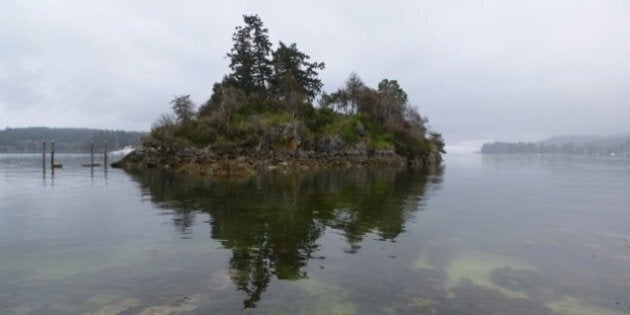
I spent last Saturday, National Aboriginal Day, at Centennial Park in Ganges on Salt Spring Island. My family joined a few hundred aboriginal and non-aboriginal people in a rally to protest the development of a luxury home over top of Coast Salish burial cairns on Grace Islet off Salt Spring.
The islet is a First Nations cemetery and well-known archaeological site. It was a common Coast Salish practice to bury high-ranking people on the tiny islets just off the shores of the Salish Sea.
A few weeks back, I wrote to Steve Thomson, B.C. Minister of Forests, Lands and Natural Resource Operations, asking him to reverse his decision to allow the development of the residence and the consequent desecration of the cemetery. His response stated that the ministry had to balance competing interests between the property owner and First Nations.
The interests of the First Nations are easy to understand -- Grace Islet is a cemetery and it has been one for a long time. The interests of the property owner are also clear, but they stem from a local government decision to zone the cemetery for residential development.
Perhaps at first, government officials didn't know the significance of the islet. However, that is not the case now and only the property owner and Minister Thomson can change the fate of the site from being almost entirely covered by a house.
If the positions are hardened and the process does not stop for Grace Islet, the least we can do is learn from this unfortunate situation. My petition to the Minister Thomson encourages him to establish a working group with First Nations and local government to identify and address the potential conflicting interests at similar sacred sites in the Straits Salish territory.
For First Nations, there is no other act more offensive than to disrespect the dead. But really, this is a notion we all can understand; non-aboriginal cemeteries are sacred too.
The situation on Grace Islet illustrates a bigger problem with aboriginal and non-aboriginal relationships in British Columbia and Canada. A fundamental inequity exists -- kick over a grave marker in Ross Bay Cemetery and there is public outrage; propose a house above First Nations burial cairns and, as long as you follow "due process," it's given the green-light.
Times are changing. Reserves are nothing like the place my father was born on in 1948 or the place my mom moved to in the early 1970s. Aboriginal people are engaged in building their communities like never before. They are exercising their right to self-determination and actively defending their indigenous and constitutional rights. Reserves are vital places where people are working hard to improve their education, health, culture and housing.
Former premier Gordon Campbell and ex-prime minister Paul Martin started forging new and exciting relationships with aboriginal people. Canadians were making significant strides at working together. Yet while recently our governments have taken another approach and appear unwilling to follow Campbell and Martin's lead there is a new generation of First Nations leaders that are stepping up to the plate and taking a leadership role in our province.
Chief Sharleen Gale of the Fort Nelson First Nation dismissed government and industry officials from an LNG conference recently when she learned that the provincial government had quietly removed environmental assessment requirements for LNG infrastructure projects in her territory.
Chief Terry Teegee of the Carrier-Sikani Tribal Council represents several communities in the path of the Northern Gateway pipeline. He's speaking out and saying no to the pipeline. But he says no isn't enough. He advocates for clean tech projects that will attract investment and create jobs by harvesting renewable resources.
And we cannot understate the leadership of Grand Chief Stewart Phillip. His calm, powerful and eloquent voice as leader of the Union of BC Indian Chiefs has been a steady, positive and productive influence for aboriginal and non-aboriginal people alike.
I had mixed feelings on National Aboriginal Day. The provincial government's unwillingness to take responsibility for its role in the desecration on Grace Islet left me disheartened. On the other hand I am encouraged to see aboriginal leaders taking a new role in the politics of this province. They are changing the relationship and that gives us all something to celebrate.
ALSO ON HUFFPOST:
